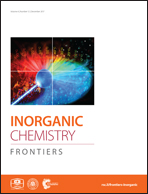Ce2PtGe3: a new ordered orthorhombic superstructure in the AlB2 family with spin glass behavior†
Abstract
A new compound Ce2PtGe3 was synthesized using arc-melting process. The compound crystallizes in an orthorhombic Cmce crystal structure with lattice parameters a = 8.5157(17) Å, b = 14.7496(29) Å and c = 4.2511(9) Å. The structure of Ce2PtGe3 can be derived from the structure of YAlGe, which is another superstructure derivative of the AlB2 prototype crystallizing in the Cmcm space group. The crystal structure of Ce2PtGe3 is composed of infinite arrays of hexagonal [Pt3Ge3] units stacked along the b-axis and the Ce sites are sandwiched between these parallel hexagonal networks, which is closely related to the other known orthorhombic superstructures Ca2AgSi3 (SG: Fmmm) and Ba2LiSi3 (SG: Fddd) in the AlB2 family. Both DC and AC susceptibility measurements reveal a spin glass state probably arising from non-magnetic atomic disorder (NMAD) from positional disorder from a part of Pt and Ge crystallographic sites. This was further supported by specific heat capacity measurements with a high value of γ = 125 mJ mol−1 K−2. The modified Curie–Weiss fitting yielded a residual magnetic moment (χ0) 0.0011 emu mol−1, and Curie paramagnetic temperature, θp = −21.5 K suggesting antiferromagnetic coupling and an effective magnetic moment of 3.09μB per Ce which indicates the presence of Ce3+. A thorough analysis of the temperature dependent resistivity data revealed that the compound might be a Kondo semiconductor at low temperature.



 Please wait while we load your content...
Please wait while we load your content...